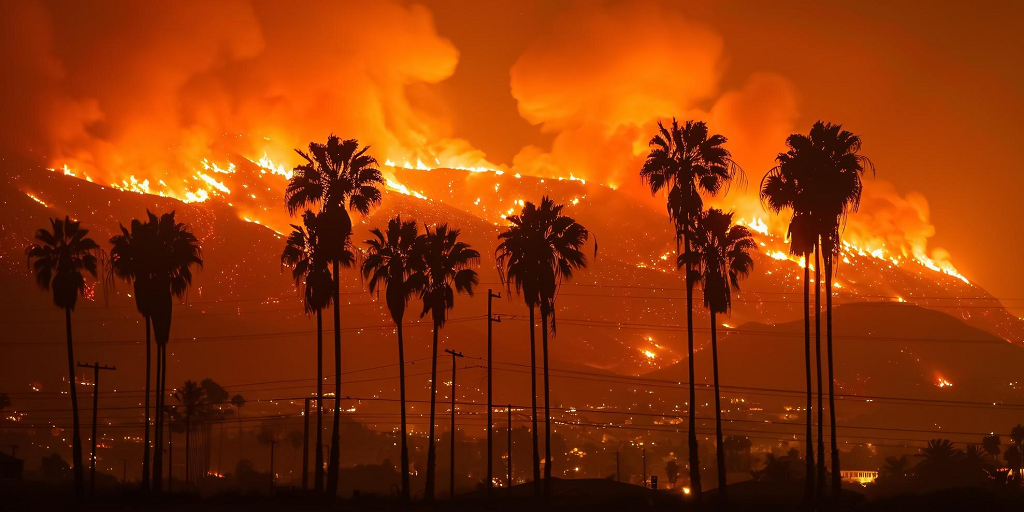
The recent wildfires in Los Angeles, now estimated to be the costliest wildfire disaster in U.S. history, are a stark reminder of the increasing need to understand and manage physical climate risks. As we emphasized in our earlier blog following hurricanes Helene and Milton, integrating climate risks into decision-making is no longer optional—it is essential.
When it comes to understanding the causes of disasters like the Los Angeles wildfires, there’s a tendency to oversimplify the narrative. The left says, “it’s climate change”. The right says, “it’s land and water management”. To truly understand and address physical climate risks, we must consider the complex interplay of factors that contribute to events like these wildfires.
The Causes of the Los Angeles Wildfires
It’s important to set the record straight: climate change did not cause the wildfires in Los Angeles. A combination of other factors did play material roles in this disaster, and these deserve scrutiny:
- Overbuilding: Development in high-risk areas, such as the wildland-urban interface, has significantly increased vulnerability. In many cases, homes and businesses have been built in regions where fire risks, prevalent because of the Santa Ana winds, are well-known.
- Land and Vegetation Management: Management of underbrush and vegetation in fire-prone areas has been a long-standing concern. While forests weren’t the primary setting for these fires, the buildup of combustible material in suburban and semi-rural areas exacerbated the spread.
- Water Resources: California’s topography and complex water network leaves many regions more vulnerable to drought conditions brought on by a warming climate, but there are no fixes as simple as “turning a valve”.
- Infrastructure Failures: Aging or poorly maintained infrastructure, such as power lines, can act as ignition sources during periods of high winds and dry conditions. Local urban water infrastructure for fighting fires was not designed for fighting wildfires.
- Policy Choices: Local and regional policies often prioritize economic development over long-term risk mitigation, such as enforcing stricter building codes or investing in preventative measures.
These factors are not partisan talking points—they are real contributors to the disaster. Yet, they are all connected and deserve more attention because of, and not instead of, climate change.
Climate Change: The Amplifier
While climate change is not the direct cause of wildfires, it significantly amplifies the conditions that make them more likely and more extreme. Rising temperatures have extended drought periods and dried vegetation, providing abundant fuel for fires. Warmer air also holds more moisture, intensifying heatwaves and further drying landscapes. Add to this the increased frequency of extreme weather events, and the stage is set for disasters like the Los Angeles wildfires to become more common.
“Property and casualty insurers, armed with arguably the world’s most sophisticated catastrophe and climate models, are pulling out of disaster-prone areas, citing unacceptable levels of risk. This is the canary in the coal mine”
The insurance market is already responding. Property and casualty insurers, armed with arguably the world’s most sophisticated catastrophe and climate models, are pulling out of disaster-prone areas, citing unacceptable levels of risk. This is the canary in the coal mine. Insurers deeming areas uninsurable sends a warning signal to financiers and asset owners that physical risks are escalating beyond what traditional systems can manage.
What Climate Models Can—and Can’t—Tell Us
Speaking of climate models, the relationship between a changing climate and factors like land management, overbuilding, and water use is complex and challenging to model. While climate models are invaluable tools for understanding risks, they come with limitations. To make informed decisions, investors and asset owners need to understand:
What Models Can Tell Us
- Long-Term Trends: Models highlight how rising temperatures, changing precipitation patterns, and other variables increase the likelihood of extreme events.
- Likelihood: They provide insight into the likelihood of specific hazards under different climate scenarios.
- Relative Risks: Models help identify regions or sectors where vulnerabilities are greatest.
What Models Can’t Tell Us
- Exact Causes: Models cannot definitively attribute a specific disaster to climate change.
- Precise Timing: While models can estimate probabilities, they can’t predict when an event will occur.
- Interdependent Factors: The complex interplay between climate and non-climate factors—like human behavior, policy, and infrastructure—is difficult to quantify.
What Models May Never Tell Us
- Human Responses: Policymakers, businesses, and communities make unpredictable choices in response to climate risks.
- Black Swans: Low-probability, high-impact events will always defy precise modeling.
- Perfect Predictions: Models are simplifications of reality, and uncertainty is an inherent part of their design.
Known Knowns: A Basis for Action
Despite these limitations, climate models provide a clear enough picture to act. Rising global temperatures, more frequent and severe weather events, and increasing vulnerabilities are “known knowns.” They form a solid foundation for integrating physical climate risks into decision-making.
The Los Angeles wildfires illustrate how climate change interacts with a range of other factors to create devastating outcomes. These interactions may be difficult to model precisely, but they underscore the urgency of addressing physical risks. Ignoring them is no longer an option.
Navigating Complexity with Confidence
The complexity of modeling physical climate risks should not deter action. Instead, it should reinforce the need for thoughtful and proactive strategies. For owners and financiers of physical assets, the real challenge lies in adapting these tools to specific circumstances and acting on the insights they provide.
As the insurance market withdraws from high-risk areas, investors and asset owners should take heed. Understanding the interplay between climate and other factors is not just a matter of building better models—it’s a matter of asking better questions (e.g., “What do we want the models to tell us?”), and preparing for a world in which ever-present physical risks are increasingly priced into the market.

Chris Ito
CEO
FFI Holdings

